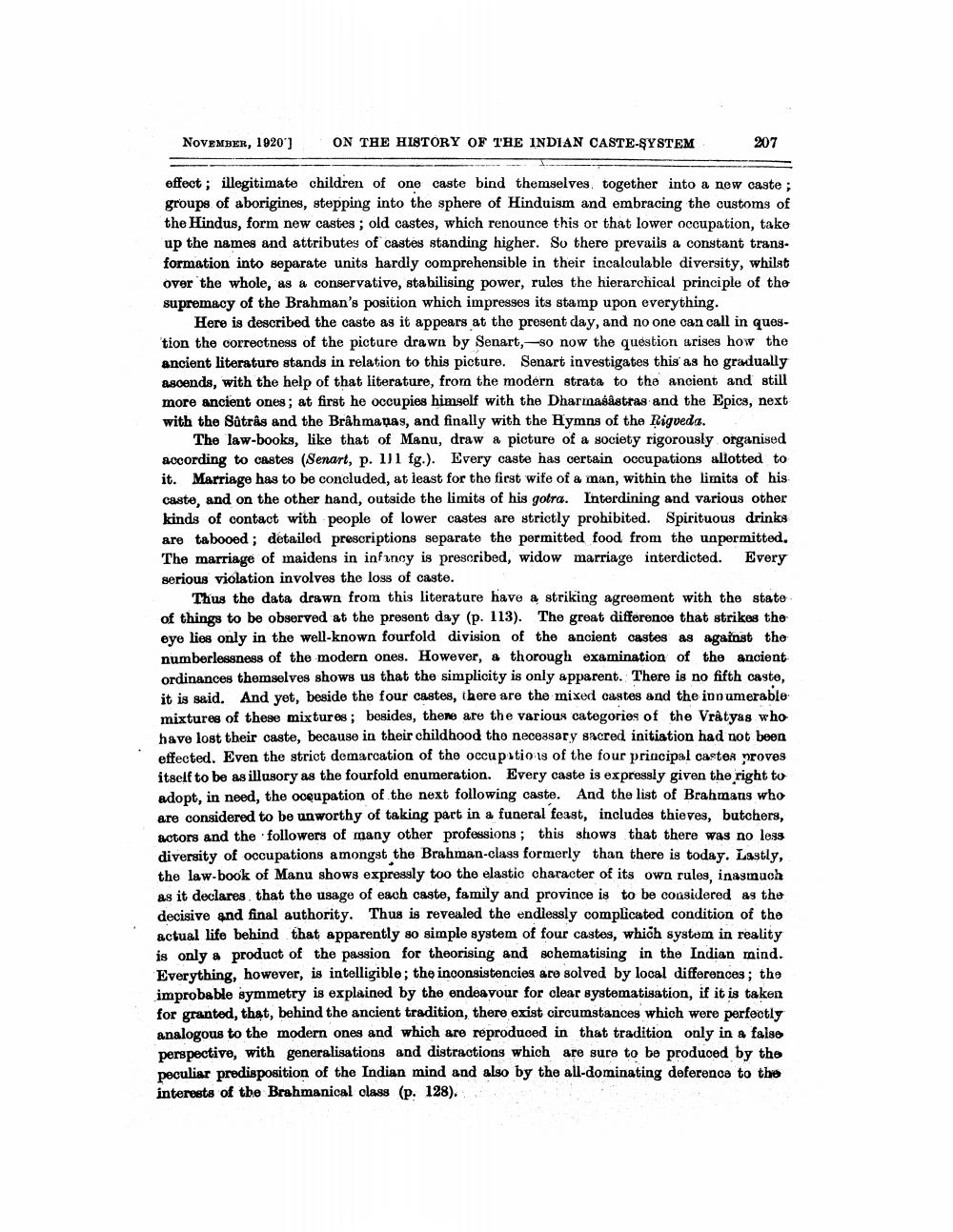________________
NOVEMBER, 1920)
ON THE HISTORY OF THE INDIAN CASTE-SYSTEM
207
effect; illegitimate children of one caste bind themselves together into a new caste; groups of aborigines, stepping into the sphere of Hinduism and embracing the customs of the Hindus, form new castes ; old castes, which renounce this or that lower occupation, take up the names and attributes of castes standing higher. So there prevails a constant transformation into separate units hardly comprehensible in their incalculable diversity, whilst over the whole, as a conservative, stabilising power, rules the hierarchical principle of the supremacy of the Brahman's position which impresses its stamp upon everything.
Here is described the caste as it appears at the present day, and no one can call in question the correctness of the picture drawn by Senart, so now the question arises how the ancient literature stands in relation to this picture. Senart investigates this as he gradually ascends, with the help of that literature, from the modern strata to the ancient and still more ancient ones; at first he occupies himself with the Dharmasastras and the Epics, next with the Satrás and the Brahmanas, and finally with the Hymns of the Rigveda.
The law-books, like that of Manu, draw a picture of a society rigorously organised according to castes (Senart, p. 111 fg.). Every caste has certain occupations allotted to it. Marriage has to be concluded, at least for the first wife of a man, within the limits of his caste, and on the other hand, outside the limits of his gotra. Interdining and various other kinds of contact with people of lower castes are strictly prohibited. Spirituous drinks are tabooed; detailed prescriptions separate the permitted food from the unpermitted. The marriage of maidens in infincy is prescribed, widow marriage interdicted. Every serious violation involves the loss of caste.
Thus the data drawn from this literature have a striking agreement with the state of things to be observed at the present day (p. 113). The great difference that strikes the eye lies only in the well-known fourfold division of the ancient castes as against the numberlessness of the modern ones. However, a thorough examination of the ancient ordinances themselves shows us that the simplicity is only apparent. There is no fifth caste, it is said. And yet, beside the four castes, there are the mixed castes and the ippumerable mixtures of these mixtures; besides, there are the various categories of the Vrâtyas who have lost their caste, because in their childhood the necessary sacred initiation had not been effected. Even the strict demarcation of the occupatio is of the four principal castes proves itself to be as illusory as the fourfold enumeration. Every caste is expressly given the right to adopt, in need, the oceupation of the next following caste. And the list of Brahmans who are considered to be unworthy of taking part in a funeral feast, includes thieves, butchers, actors and the followers of many other professions ; this shows that there was no less diversity of occupations amongst the Brahman-class formerly than there is today. Lastly, the law-book of Manu shows expressly too the elastic character of its own rules, inasmuch as it declares that the usage of each caste, family and province is to be considered as the decisive and final authority. Thus is revealed the endlessly complicated condition of the actual life behind that apparently 80 simple system of four castes, which system in reality is only a product of the passion for theorising and schematising in the Indian mind. Everything, however, is intelligible; the inconsistencies are solved by local differences; the improbable symmetry is explained by the endeavour for clear systematisation, if it is taken for granted, that, behind the ancient tradition, there exist circumstances which were perfectly analogous to the modern ones and which are reproduced in that tradition only in a false perspective, with generalisations and distractions which are sure to be produced by the peculiar predisposition of the Indian mind and also by the all-dominating deference to the interests of the Brahmanical class (p. 128).




